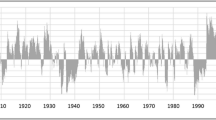Abstract
Developing an understanding of wetland hydrology that is free from site-specific constraints is difficult. Many hydrologic studies are focused upon a single site and the development of water-budget components. Our previous research (Cole et al. 1997) examined the hydrology of several wetlands based upon monthly sampling during the growing season. Those data did not provide adequate information on moisture regimes and did not tell us enough about year-round hydrodynamics. Our new objective was to expand hydrologic analyses to a larger proportion of our reference wetlands and extend them over a longer period of time. We continued to organize our wetlands and our analyses around hydrogeomorphic (HGM) principles. We found ground-water-dominated wetlands (riparian depressions and slopes) to be the wettest sites. Surface-water systems (headwater and mainstem floodplain wetlands) were drier. We found little difference between slopes and the floodplain wetlands in the amount of time water was within the root zone. Riparian depressions were wetter longer, as the average duration of water within the root zone was almost a year for riparian depressions and much less for all other wetland types. Disturbance seemed to play a large role in hydrologic behavior, even more than did HGM classification. We believe that knowledge of HGM subelass might serve as a useful surrogate for actual knowledge of site-specific hydrology. The level of uncertainty increases with surface-water systems, but we have shown a large degree of predictability by HGM subelass. Our data likely have applicability within the entire Ridge and Valley province of the Appalachian Mountains in the United States, although our conclusions have not been tested over that wide latitudinal range.
Similar content being viewed by others
Literature Cited
Brinson, M. M. 1993. A hydrogeomorphic classification for wetlands. U.S. Army Corps of Engineers, Waterways Experiment Station, Vicksburg, MS, USA. Technical Report WRP-DE-4.
Brinson, M. M. 1995. The HGM approach explained. National Wetlands Newsletter 17:7–13.
Brinson, M. M. 1996. Assessing wetland functions using HGM. National Wetlands Newsletter 18:10–16.
Brooks, R. P., C. A. Cole, D. H. Wardrop, L. Bishel-Machung, D. J. Prosser, D. A. Campbell, and M. T. Gaudette. 1996. Wetlands, wildlife, and watershed assessment techniques for evaluation and restoration (W3ATER). Vo. 1, 2A, and 2B. Penn State Cooperative Wetlands Center, University Park, PA, USA. Final report to the Pennsylvania Department of Environmental Protection. Report Number 96-2.
Carter, V. 1986. An overview of the hydrologic concerns related to wetlands in the United States. Canadian Journal of Botany 64: 364–374.
Cole, C. A. and R. P. Brooks. 2000. A comparison of the hydrologic characteristics of natural and created mainstem floodplain wetlands in Pennsylvania. Ecological Engineering 14:221–231.
Cole, C. A., R. P. Brooks, and D. H. Wardrop, 1997. Wetland hydrology as a function of hydrogeomorphic (HGM) subclass. Wetlands 17:456–467.
Cole, C. A., R. P. Brooks, and D. H. Wardrop. 1998. Building a better wetland—a response to Linda Zug. Wetland Journal 10:8–11.
Cooper, D. J., L. H. MacDonald, S. K. Wenger, and S. W. Woods. 1998. Hydrologic restoration of a fen in Rocky Mountain National Park, Colorado, USA. Wetlands 18:335–345.
Cowardin, L. M., V. Carter, F. C. Golet, and E. T. LaRoe. 1979. Classification of wetlands and deepwater habitats of the United States. U.S. Department of the Interior, Fish and Wildlife Service. Office of Biological Services, Washington, D.C., USA. FWS/OBS-79/31.
Doss, P. K. 1993. The nature of a dynamic water table in a system of non-tidal, freshwater coastal wetlands. Journal of Hydrology 141:107–126.
Doss, P. K. 1995. Physical-hydrogeologic processes in wetlands. Natural Areas Journal 15:216–226.
Gaudette, M. T. 1998. Modeling wetland songbird community integrity in central Pennsylvania. Ph.D. Thesis. School of Forest Resources, The Pennsylvania State University, University Park, PA, USA.
Glenn, M. S., and M. Woo. 1997. Spring and summer hydrology of a valley-bottom wetland, Ellesmere Island, Northwest Territories, Canada. Wetlands 17:321–329.
Kentula, M. E. and T. K. Magee. 1999. Foreword (to the Special section on wetlands in an urbanizing landscape). Wetlands 19:475–476.
LaBaugh, J. W. 1986. Wetland ecosystem studies from a hydrologic perspective. Water Resources Bulletin 22:1–10.
Lent, R. M., P. K. Weiskel, F. P. Lyford, and D. S. Armstrong. 1997. Hydrologic indices for nontidal wetlands. Wetlands 17:19–30.
Minitab, Inc. 1998. Minitab statistical software, version 12.2. State College, PA, USA.
National Research Council (NRC). 1995. Wetlands. Characteristics and Boundaries. National Academy Press. Washington, D.C., USA.
O’Brien, A. L. 1977. Hydrology of two small wetland basins in eastern Massachusetts. Water Resources Bulletin 13:325–340.
Owen, C. R. 1995. Water budget and flow patterns in an urban wetland. Journal of Hydrology 169:171–187.
Richter, B. D., J. V. Baumgartner, J. Powell and D. P. Braun. 1996. A method for assessing hydrologic alteration within ecosystems. Conservation Biology 19:1163–1174.
Runhaar, H. J., J. P. M. Witte, and P. H. Verburg. 1997. Ground-water level, moisture supply, and vegetation in the Netherlands. Wetlands 17:528–538.
Shaffer, P. W., M. E. Kentula, and S. E. Gwin, 1999. Characterization of wetland hydrology using hydrogeomorphic classification. Wetlands 19:490–504.
Shaffer, P. W., C. A. Cole, M. E. Kentula, and R. P. Brooks. 2000. Wetland hydrologic data: How important is water level measurement interval? Wetlands 20:148–161.
Wardrop, D. H. 1997. The occurrence and impact of sedimentation in central Pennsylvania wetlands. Ph.D. Thesis. Ecology Program. The Pennsylvania State University, University Park, PA, USA.
Zar, J. H. 1984. Biostatistical Analysis. Prentice-Hall, Inc., Englewood Cliffs, NJ. USA.
Author information
Authors and Affiliations
Corresponding author
Rights and permissions
About this article
Cite this article
Cole, C.A., Brooks, R.P. Patterns of wetland hydrology in the Ridge and Valley province, Pennsylvania, USA. Wetlands 20, 438–447 (2000). https://doi.org/10.1672/0277-5212(2000)020<0438:POWHIT>2.0.CO;2
Received:
Revised:
Accepted:
Published:
Issue Date:
DOI: https://doi.org/10.1672/0277-5212(2000)020<0438:POWHIT>2.0.CO;2




